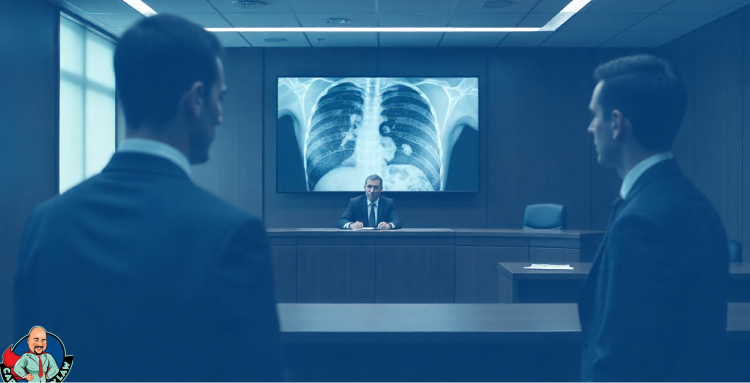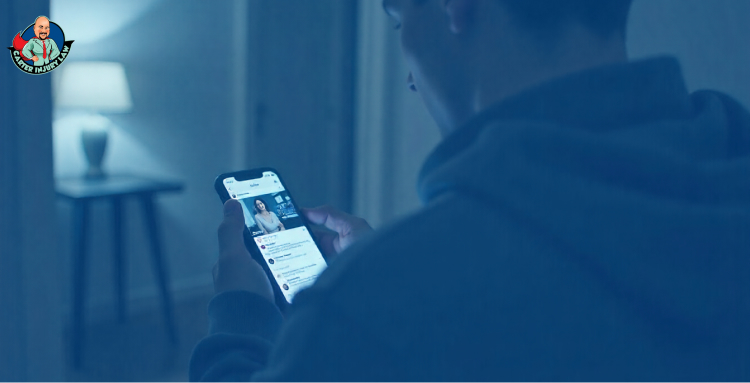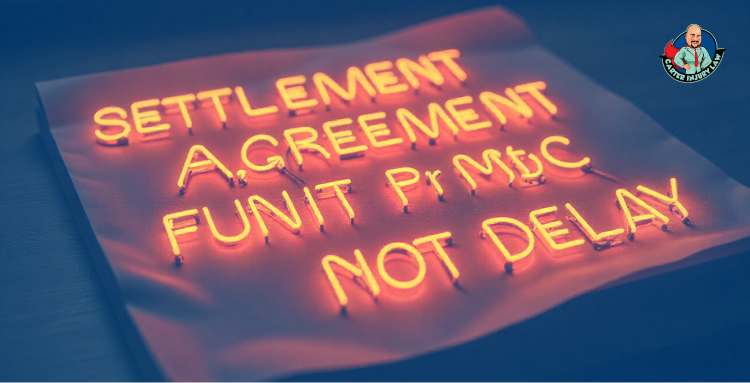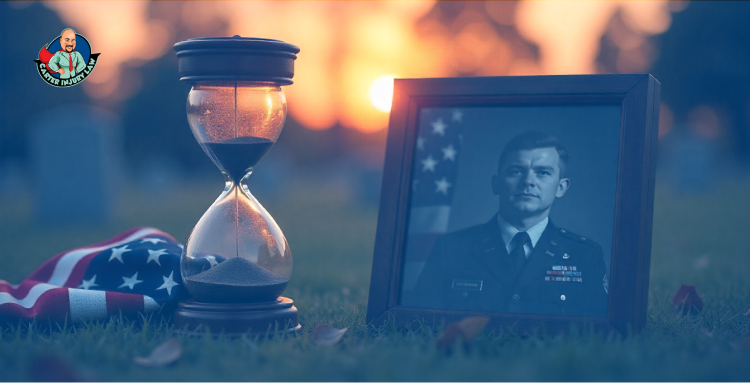Call US
24/7
Free Confidential case Evaluation
(813)922-0228Call US
24/7
Free Confidential case Evaluation
(813)922-0228Loading...


You get a letter in the mail. It's from the defense attorney. Inside, it says you’ve been scheduled for a “compulsory medical examination.” Sounds routine enough, right? However, then the questions start piling up.
Who’s this doctor? Why aren’t you seeing your own? What happens if you say the wrong thing or say too much? And here’s the part no one tells you until it’s too late. That exam could be the moment your whole case starts to shift.
Let’s talk about what really happens behind those doors.
If you're in a personal injury lawsuit, sooner or later the defense is going to schedule something called a compulsory medical examination. Not your regular doctor, not someone who's treated you before. This is their doctor and hand-picked expert.
Now, they’ll sometimes try to call it an IME, an “independent medical exam,” which sounds neutral enough. Don’t fall for it. These exams aren’t independent, and they’re definitely not neutral. This doctor is being paid a lot to examine you and give the insurance company an opinion they can use.
And that’s exactly what they do. They look for ways to say you’re not injured. Or if you are injured, it wasn’t from this accident. Or maybe it was, but now it’s magically healed.
So no, this isn’t just a routine check-up. It’s a key move in the defense playbook. And it sets the tone for what comes next, starting with who’s really pulling the strings behind that exam.
Let’s be clear, this doctor doesn’t work for you. The defense attorney chooses them, hires them, and pays them. And not in pocket change. Some of these physicians are making thousands per exam, often seeing one injury plaintiff after another, day in and day out. It’s a revolving door.
From the moment you walk in, the boundaries are clear. You’ll usually be asked to sign something confirming there's no doctor-patient relationship. That means they're not treating you, they’re not diagnosing for your benefit, and they’re definitely not invested in your recovery.
So when the report comes back saying your injuries are minor, unrelated, or magically resolved, it’s no accident. A 2022 review by the Journal of Legal Medicine found that CME doctors agreed with the plaintiff's injury severity just 18% of the time. That’s not a coincidence but a pattern.
And this is exactly why you’ve got to go in prepared. Next up is how to protect yourself the moment you step into that exam room.

This part matters more than people think. If you're going to a CME, don’t walk in alone. We send a professional videographer to every single one of our clients. Because when that report comes back saying things didn’t hurt or you didn’t complain, we’ve got the footage to show otherwise.
It’s not just about catching a lie. It’s about keeping things honest. If the doctor lifts your arm and you wince in pain, that moment’s on record. If you clearly say, “That hurts,” and they try to claim you didn’t, we can play the video.
In fact, according to the National Institute for Trial Advocacy, when video is used, plaintiffs are 34% more likely to successfully challenge inaccurate CME testimony. That’s not a small number.
You can also have a court reporter there. Sometimes we bring both. They’ll document every word, just in case anything gets twisted later.
Attorney David Carter explains why CMEs can greatly impact your injury case and what to watch for during your exam
And now that you know how to protect yourself during the exam, let’s talk about how to protect yourself from your own words.
A simple rule of thumb when attending a CME is to only answer the questions that are asked. You’re not there to make conversation. You’re not there to win anyone over. You’re there because the defense wants their doctor to look for holes in your case.
Some of these doctors will talk sports, ask about your kids, maybe comment on the weather like it’s small talk in a grocery line. Don’t take the bait. That kind of friendly chatter isn’t just small talk, it’s bait for you to open up. And anything you say can end up in their report.
So be honest, be polite, but stay focused. If something hurts during the exam, say it. Out loud. Don’t try to tough it out. If you feel pain, speak up clearly so there’s no confusion later.
Like we tell our clients: they’re not your friend, they’re not here to help you… answer their questions directly. Now let’s look at what happens if you show up late, or worse, don’t show at all.
This part’s not negotiable. If you’ve been scheduled for a CME, show up early. We tell our clients to be there at least 30 minutes ahead. Because if you’re even 15 minutes late, some of these doctors will cancel the exam on the spot and slap you with a massive bill.
And we're not talking about a small fee. According to the Florida Injury Law Journal, some CME doctors in Florida have charged up to $7,000 for no-shows or late arrivals. That’s the kind of bill you don’t want showing up in your mailbox.
One way we protect against this? We get a court order before the exam. That judge-signed order locks in the rules about how much notice they need, what happens if someone’s late, when the report is due, and more. Without it, the defense can play fast and loose with the rules.
Once that clock starts ticking, every step has to be done right. And the next step is to understand what happens after the exam ends.

Once the exam is done, the doctor heads back to their office to write a report. By law, they usually have 30 days to send it in. However, this report doesn’t just land in front of a judge or jury. It’s not automatic evidence.
What really matters is what that doctor says in court. Their testimony, not their paperwork, is what carries weight. But that report still plays a big role. It gives your lawyer a preview of the doctor’s stance about what they’re claiming, what they’re downplaying, and where they might’ve stretched things a little too far.
That’s why your attorney reads it carefully. Every word in that report helps shape the cross-examination. Knowing their playbook before they take the stand can make all the difference.
Next, let’s look at who’s got your back when you walk into that exam room and why not every law firm treats it the same.
This is where law firms start to differ. Some attorneys stay behind the scenes when it comes to CMEs. They’ll prep you, sure but when it’s time for the actual exam, you’re on your own. However, that’s not how we do it.
We go with our clients. We wait in the parking lot. We walk in together. We meet the videographer together. And when the exam starts, we’re right there in the room. Making sure everything goes the way it’s supposed to.
It’s not about dramatics. It’s about presence. And when the defense knows we’re paying attention, they tend to behave a little differently. Now let’s talk about how their opinion lands in court and why that report they write is only the beginning.

It's unsettling to be told to show up for a medical exam in order to be judged rather than healed. You're not walking into a clinic; you're walking into someone else's plan. And it’s okay if that feels off.
We understand the quiet pressure that builds before a CME. The letters, the schedule, the uncertainty, none of it is intended to make you feel heard. However, that is why we provide something unique. A chance to talk, free of charge. Just a conversation about what this exam really means and how to prepare for it with your rights intact.
Whether the exam is days away or still sitting unopened in your mailbox, you can depend on us.

Got a letter from your insurance company about an independent medical examination, or IME? What exactly is this that your insurance company is asking you to attend? Simply put, it’s a medical check-up, but not with your regular doctor. Instead, it’s with a doctor chosen by the insurance company. That could be a chiropractor, a medical doctor, or even a specialist like an orthopedic physician. The goal is to get an evaluation from their side, not yours.
Florida law requires every driver to carry Personal Injury Protection (PIP) benefits, which cover at least $10,000 in medical bills after an accident, no matter who’s at fault. This means your insurance company has to pay for your medical treatment up to that amount. But when they schedule an IME, it’s often because they want to verify your condition and decide whether to keep paying those bills.
This leads right into why insurance companies push for these exams, and how it can affect your benefits. Let’s look at that next.
Insurance companies don’t schedule these exams just out of curiosity, they’re usually trying to cut off your benefits. You’ve paid your premiums faithfully, expecting that if you get hurt, your medical bills will be covered.
However, many insurers, like Progressive in particular, are quick to send you to their chosen doctors to review your case. More often than not, these doctors end up saying your treatment isn’t necessary anymore, and just like that, your benefits stop.
It’s frustrating to take time off work, travel to appointments, and then face the possibility that your care will be cut short. It feels like a constant battle just to get what you’ve already paid for.
Understanding what happens during these exams helps you stay prepared and protect your rights. So, what actually goes on during an IME? Let’s break down the process.

When you show up for an IME, the process is pretty straightforward but don’t let that fool you. You’ll meet the doctor the insurance company picked, they’ll examine you, ask questions, maybe review your medical records, and then write a report.
Taking time off work to attend, traveling to an unfamiliar doctor’s office, and dealing with the stress of the whole situation is a burden on top of an already difficult time. And often, the doctor’s conclusion is that your care is “no longer reasonable or necessary.” That’s the phrase they use to justify stopping payments.
This happens in about 70% of IMEs, where the exam leads to denial or reduction of medical benefits. So while you’re doing everything right, the system is set up to challenge your claim at this stage.
Next, we’ll talk about how we fight back against unfair doctors and protect your right to the care you deserve.
Not all doctors assigned for these exams play fair. Some have earned a reputation for biased or even dishonest reports that don’t reflect the full picture of your injury. When we spot these providers, we accept it and we formally object. That means telling the insurance company, “No, we won’t accept that doctor,” and standing up for you.
In certain situations, the law even allows us to refuse an exam with a provider known to be obstructive or untruthful. If the insurance company insists, we’re prepared to take legal action, including suing for the benefits you’re rightfully owed.
Knowing when and how to push back is key to protecting your claim. But there’s more you can do to safeguard yourself during the exam itself.
Not a fan of reading long blogs? No problem. In this video
I break down exactly what an independent medical exam is, why insurance companies send you to one, and how it could impact your case.
If you’re going to an IME, one of the smartest things you can do is record it. To protect themselves, we always recommend that our clients video their exams. Insurance companies don’t love this idea. Some will insist that you hire a professional videographer, but we don’t believe that’s necessary. There’s no legal rule in Florida saying you can’t use your own phone or have someone you trust help with the recording.
Why does it matter? Because things get misrepresented. With a recording, you’ve got proof. It’s your word backed by video, not just your memory versus theirs.
Next, we’ll look at how insurance companies sometimes schedule these exams without even checking with you first, and what we do when that happens.

One of the more frustrating things we see is insurance companies setting IME appointments without even asking if the date works for you. They just send a letter with a time and place, expecting you to rearrange your life around it. That’s called unilateral scheduling, and no, we don’t let it slide.
When that happens, we step in. We tell the insurance company they need to coordinate with you first. You deserve to have a say in when and where this appointment happens. It doesn’t mean you can skip it altogether but it does mean it needs to be reasonable. You shouldn’t have to miss work, scramble childcare, or drop everything for an appointment you didn’t agree to.
Now, even with all of that, you still have to go. And here’s why skipping it can hurt your case.
We get it. The whole process feels unfair. You're being sent to a doctor you didn’t choose, at a time you didn’t ask for, and it’s clear the exam isn’t meant to help you heal. But as frustrating as that is, skipping the IME can do more damage than the exam itself.
Under your insurance policy, you’re required to “reasonably comply” with requests like these. That means showing up, even if you disagree with the setup. If you don’t go, your insurer can and almost always will deny your benefits. According to the Florida Bar Journal, nearly 100% of missed IMEs lead to automatic denial of coverage.
More importantly, if you ever need to sue for those benefits later, not attending the exam gives the other side an easy argument. They’ll say you didn’t cooperate, and that can seriously hurt your case. So yes, go to the appointment but do it on your terms, with support and preparation.
Next, let’s look at how these IME reports can reach far beyond just your PIP benefits and affect your entire personal injury case.

You might’ve also heard the term CME thrown around and wondered if it’s the same thing. It’s not. A CME, or Compulsory Medical Examination, comes up during the litigation stage. That means it's requested by the defense attorney when a lawsuit is already in progress.
An IME, on the other hand, usually happens before a lawsuit is even filed. It’s set up by your own insurance company as part of their claims process. Both exams serve similar purposes but they come at different times and involve different players.
For now, if you’ve gotten a letter about an IME, the next step is understanding what to do with it and how we can help you through it.
Read these relevant blogs to address pressing circumstances:
Getting that IME letter can throw everything off. You're being told to show up for an exam with a doctor you’ve never met who might be there to shut down your care. It’s stressful, it’s confusing, and it can feel like the system is working against you.
That’s exactly why we’re here. We walk our clients through every part of the process, from what to expect at the exam to how it might impact your case later on.
If you’ve been scheduled for an IME and you’re unsure about what to do, call us. We offer free, confidential evaluations, no obligations attached.

After an accident, a lot of people think the insurance company is watching them right away. Like someone’s already out there with a camera as soon as the claim is filed. That’s usually not how it works.
Surveillance doesn’t happen in every case. It costs money, and most companies won’t spend that unless they believe your case could cost them a lot more. If you’re asking for a higher settlement or you’ve filed a lawsuit, that’s when the red flags go up for them.
And when they do decide to watch, they don’t always make it obvious. Let’s talk about that…
When people think about being followed after a personal injury, they picture someone sitting in a van, holding a camera, waiting for that one moment they can use against you. And honestly, that’s not far from reality.
Surveillance like this is usually done by private investigators. They blend in. Their cars don’t have logos. Their cameras are discreet. And they’re not there by accident. They’ve been hired to watch and wait.
However, this kind of effort doesn’t happen right away. It usually starts once a lawsuit is filed and the claim looks like it’s going to cost the insurance company real money. Before that, most of them don’t want to spend the resources.
Legally, they can record you in public spaces. If you’re walking through a parking lot or sitting at a park, that’s fair game. However, there are lines. They can’t peek into your windows. They can’t film you inside your house or in private areas where you’d reasonably expect privacy. Those boundaries matter.
Claims Journal reported that private investigators are used in about 1 in 5 litigated personal injury cases, especially when claims go beyond $50,000. It’s not routine, but it’s common enough to take seriously.
Still, the camera outside isn’t always the biggest concern. These days, the real risk often starts with something most of us use every single day.

Let’s say you tell the insurance company you can’t lift anything. You’re in pain, and you’re not exaggerating. But a few days later, you roll your garbage can down the driveway. It’s part of your routine. Doesn’t seem like a big deal. Except someone’s filming and now they’ve got you on video doing the one thing you said you couldn’t.
That’s where the real damage happens.
It’s not about whether you took the trash out. It’s about whether your words match your actions. Juries don’t expect perfection. They expect honesty. And if something you said under oath doesn’t line up with what ends up on camera, the case can start to slip.
According to the Insurance Research Council, surveillance footage leads to a lower payout in 15 to 20 percent of disputed injury claims.
That’s why being accurate matters more than sounding limited. And while in-person surveillance can cause these problems, it’s nothing compared to what can come from something as small as a social media post.
These days, the camera doesn’t have to be in a van. It’s already in your pocket. Social media has become one of the easiest ways for insurance companies to gather information, and they don’t need a private investigator to do it.
Even if your profile is set to private, that doesn’t mean it’s off-limits in a legal case. Courts have allowed access to private posts, photos, comments, and even messages, depending on the situation. If a judge thinks the content might be relevant to your injury or credibility, they can order you to hand it over.
That’s what makes social media so risky. You don’t have to post something dramatic. Even a picture of you smiling at a friend’s barbecue could be used to question how you’re feeling or what you’re capable of. It doesn’t take much to shift the tone of a case.
And while you can’t always control who’s watching, you can control what you post or whether you post at all… Here’s David Carter with a quick explanation of what’s at stake and what not to post.
When it comes to social media during an injury case, the best move is simple: pull back.
Option one is to deactivate your accounts. Not forever, just while the case is active. It’s the cleanest option. No posts, no pictures, no chance something gets taken out of context. It also removes the temptation to scroll and share like nothing happened.
Option two is to stay quiet. Keep your profile, but use it just to browse. Don’t post anything, don’t comment, and definitely don’t let anyone tag you in photos. Most platforms have settings to turn tagging off.
Option three is for the ones who absolutely have to stay visible. Maybe you run a business online, or maybe social media is part of your income. If that’s the case, only post neutral content. No pictures of yourself, no updates about your health, and nothing that could be twisted into an argument against your injury.
The Journal of Legal Technology Risk reported that people who post during an open injury case are three times more likely to end up under surveillance. Not because they’re doing something wrong, but because the posts attract attention.
And once the defense is looking, they won’t stop at Facebook or Instagram. They’ll dig through everything. Which brings us to the next thing you should be ready for…

A deposition is where your words start to shape the case. And once you’ve said something under oath, it sticks. If you tell them you can’t lift anything, and then later there’s footage of you unloading groceries or moving a chair, that becomes a problem.
That’s what they’re really looking for. Contradictions. Not signs that you’re completely healed or back to full strength. Just enough inconsistency to create doubt in front of a jury.
According to Law360’s Litigation Trends Report, in 1 out of 4 injury cases involving surveillance, the footage is used to challenge testimony, not to disprove the injury itself. It's about trust. And once a jury starts questioning that, the rest of the case can get shaky.
Which is why staying consistent is part of your strategy. The next step? Knowing what to expect when the insurance company plans to use surveillance against you.
You won’t always be left wondering. If the defense has surveillance footage they plan to use, they’re required to disclose it. It usually shows up in what’s called an exhibit list—a document that outlines what evidence they intend to bring to mediation or trial.
Here’s the key difference: at mediation, they don’t have to share everything upfront. It’s more flexible. But when trial gets closer, the rules tighten. If they want to use that footage in court, they have to show their hand.
That’s where Carter Injury Law pays extra attention. We review every exhibit list the moment it’s filed. If there’s video evidence listed, we dig in, prepare, and make sure it doesn’t catch anyone off guard. Being proactive makes all the difference when you're walking into a negotiation or courtroom.
So if it’s listed, we’ll know. And we’ll be ready. Next, let’s talk about what kind of footage actually changes a case and what doesn’t.

There’s a difference between watching and crossing a line. Insurance companies are allowed to observe what happens on sidewalks, in parking lots, or at the grocery store. That part is legal. However, they can’t peer through your windows, trespass onto private property, or install hidden devices near your home.
The legal boundary is simple: if you're in a place where the general public has access, surveillance is usually fair game. The moment it enters your fenced backyard, your phone, your home office, the protections begin to apply.
Still, those lines can blur, especially when you don’t have someone watching out for you. Having an attorney early on means having someone who understands where the boundaries are and how to act if they’re pushed.
And that brings us to your honesty, your story, and how you carry that forward in your case. Let’s close by talking about what juries actually care about when all is said and done.
Surveillance isn’t some secret trap set to catch you being human. It’s a tool. And like most tools in injury litigation, it’s less about the act and more about the story that follows.
That’s why early legal guidance can go a long way. If you’re unsure whether a post is safe, if a message from an adjuster feels a little too casual, or if someone starts asking questions that make your stomach twist, talk to us.
Carter Injury Law offers free, confidential consultations. You don’t need to have a case file in hand or a strategy mapped out. Even if you’re just wondering what to post, we’re here to help you protect your story before someone else tries to rewrite it.

You don't really prepare for the time when you'll need a lawyer. It usually occurs following an accident, a phone call, or a hospital visit that separates your life into before and after. And in the middle of all that, you’re expected to make legal decisions fast.
So you Google. You scroll. You try to read between the lines of star ratings and office photos. Everyone promises to fight for you. Everyone claims they care. Still, how do you know who’s actually going to show up when it matters?
That’s the thing, no one really prepares you for the injury nor the paperwork, and definitely not this next part…
A lot of people sign with the first lawyer they call. No interviews. No comparisons. Just a quick phone call and that’s it. They’re in.
Now, I get it. When you’ve just been in an accident or you’re dealing with a serious injury, the last thing you want is to feel like you're shopping around. However, this decision deserves your time. It's not like picking a mechanic. This is someone who may be handling your case for months or even years.
In fact, 68% of clients only consult one attorney before signing a contract (Clio 2023 Legal Trends Report).
And you know what that often leads to? Regret. Not always but often enough. Because they find out later the attorney doesn’t actually go to trial. Or they never speak to the same person twice. Or worse, they feel like a number instead of a human being.
Interviewing more than one attorney helps you see the difference between someone who just wants to sign a case and someone who’s actually going to stand with you. You learn who listens. Who asks the right follow-up questions. Who’s transparent about their strategy and who gives vague answers and promises the moon.

That first call with an attorney? It’s your chance to figure out whether this is someone you trust enough to guide you through what could be a long and emotional process.
So ask real and specific questions. Start with: Have you handled a case like mine before? Not just any case. Your case. If it’s a car crash where the other driver ran a red light, ask how they’ve handled that exact situation. If it’s a nursing home neglect case, ask what they’ve seen before. Details matter but experience matters more.
Next, ask: If my case doesn’t settle, will you take it to trial? Some firms don’t file lawsuits. They settle fast and move on. That’s fine when the offer is fair—but if it’s not, you need someone who’s not afraid of a courtroom. You don’t want to find out later that your case is being handed off because your lawyer wasn’t prepared to fight.
And don’t forget to ask: Will you personally be handling my case? It’s a fair question. In larger firms, the attorney you speak to first might not be the one actually working your file. Could be someone else entirely. That doesn’t always mean it’s a bad setup but you deserve to know who you’ll be working with and what their experience is.
And that brings us to one of the most important questions of all…
Let’s say your case doesn’t settle right away. The insurance company lowballs the offer, or they flat-out deny the claim. What happens then?
That’s where you really find out what kind of attorney you hired.
Some lawyers run what's called a "max and settle" operation. They take the case, send a demand, and hope it settles without ever filing a lawsuit. That can work fine if the offer’s fair. But when it’s not, you need someone ready to step into court, not step aside.
So ask: Are you willing to litigate if we need to? And not just “in theory.” Have they actually done it? Do they file lawsuits regularly? Will they handle it or pass it off?
Because here’s the thing: only 4% of personal injury cases ever make it to trial, (U.S. Department of Justice, Bureau of Justice Statistics), but when they do, the payout is often 3 times higher than pre-suit settlements.
That’s a huge difference. And unfortunately, some firms will refer your case out the minute it gets complicated. Why? Sometimes it’s about the fee. Settling in-house often means they keep a larger cut. Referring it out? That usually means giving up a percentage to another lawyer.
Let’s break it down:
The lawyer's fee is usually a third, or roughly $33,000, if you settle for $100,000 up front.
That fee, however, increases to 40%, or $120,000, if you proceed to trial and win $300,000. If the lawyer sent your case to another lawyer, they might only receive a quarter of that, which is about $30,000.
For some lawyers, that kind of math quietly shapes how far they’re willing to take your case, whether they say it out loud or not.
We don’t refer out our litigation cases. If your case needs to go to court, we take it there ourselves. You stay with the same team. Same attorney. Same phone number. And speaking of staying close, let’s talk about why having a local lawyer matters just as much. Watch this quick video where David Carter breaks down how to choose the right personal injury lawyer and what he wishes every client knew before signing a contract .
These days, a lot of firms are expanding across the state or even the country by renting office space wherever they want to say they “serve.” They slap a local phone number on the site and a nice photo of the city skyline, but they’re not actually here. You call them, and you're routed to a call center. You ask to meet the attorney, and suddenly, it’s Zoom or nothing.

Now, there’s nothing wrong with remote options. However, if you're hiring someone to represent you in your community, especially in a serious case like a car crash or wrongful death, don’t you want someone who knows the roads, the local adjusters, and the judges? Someone who can actually walk into the courthouse if needed?
When a lawyer lives in your town, their name means something. Their reputation was developed in church pews, at the grocery store, and while waiting in line at the coffee shop, not on Google ads. People know who they are. And if that lawyer drops the ball? The community remembers.
That's why I always tell people that you're choosing a relationship rather than just hiring a lawyer. And in any relationship, trust starts with presence.
A lot of folks don’t realize this is even something they can ask. They assume it’s normal to only talk to case managers or voicemail boxes. And hey, support staff are important. No good law firm runs without them. However you didn’t hire a receptionist. You hired a lawyer. And you should know exactly who that is.
If you're about to trust someone with your future, you should at least know their name, their voice, and how to get a hold of them. Do they give out their direct number? Do they have a response time policy? If you call with a real concern, will they get back to you that day or will you get a polite email two weeks later?
So let’s finish this out. If you're still wondering how to actually know you've found the right attorney for you... there’s one last thing to consider.

In Florida, you have the legal right to cancel that agreement within 3 business days. It's called the 3-day cancellation rule, and most people don’t even know it exists.
We take that a step further. We offer a 30-day no-fee satisfaction guarantee. That means if you sign with us and decide within the first month that it’s not the right fit, you can walk away with no hard feelings.
If it doesn’t feel right early on, it probably won’t get better with time. And that’s okay. Choosing a lawyer shouldn’t feel like locking into a contract you can’t get out of. It should feel like hiring someone who actually wants to earn your trust.
And you'll know when you've found someone who actually shows up for you, listens, and responds to your inquiries. Because it won’t feel like a gamble anymore. It’ll feel like someone’s finally in your corner.
Google reviews are a good place to start but they shouldn’t be the only thing you look at. A five-star rating doesn’t tell you much unless you actually read what people are saying. Was the lawyer responsive? Did they keep the client in the loop? Did they deliver on what they promised?
That’s what you want to know.
One last tip? Don’t just skim. Take the time to read the reviews. Look for patterns in how people describe their experience. That’s where the truth usually sits.
Now, let’s say you’ve done your homework. You’ve talked to a few lawyers. You’ve checked their credentials, read the reviews, and maybe even gotten a gut feeling about who’s worth your time. So… what’s next?
If you're still in that early stage, just trying to figure it out, we're here for that too. Let’s talk.

Suppose you're doing someone a favor. You borrow a friend's car to run a quick errand, or perhaps you are the designated driver for the evening. The next thing you know, you're involved in an accident. The car has been damaged, people have been shaken up, and you're suddenly drowning in questions: am I responsible? Whose insurance pays out? Is this going to jeopardize my record?
A surprising number of accidents involve drivers behind the wheel of another person's vehicle. In fact, 1 in 5 younger drivers admit to regularly driving cars they don’t own. Accidents in borrowed cars, whether it's a family car, a roommate's ride, or even your boss's vehicle, involve a unique combination of legal responsibility, insurance red tape, and a little awkwardness.
We'll break it down clearly: who is legally liable and what to do immediately following the accident.
When you borrowed someone else's car and ended up in an accident, the most pressing question is who is legally liable. Let's look at it in more detail.
In the context of auto insurance, "permissive use" refers to situations in which the car owner has explicitly or implicitly given someone, such as you, permission to drive their vehicle. This concept is important because the owner's insurance policy often covers permissive users.
In most cases, if you drive someone else's car with their permission, their auto insurance policy will provide primary coverage in the event of an accident. This means that their insurer would typically handle any claims for damages or injuries caused by the incident.
However, permissive users should be aware that this coverage may be subject to certain limitations or higher deductibles.
“About 77% of auto insurance policies in the U.S. cover permissive use.”
Source—NAIC report
While permissive use frequently provides coverage, there are some notable exceptions:
Business Use: If you use the borrowed vehicle for business purposes, such as deliveries or ridesharing, the owner's policy may not cover any resulting accidents unless it specifically states so.
Unlicensed or Inexperienced Drivers: If the person borrowing the car does not have a valid driver's licence or is deemed inexperienced, the insurance company may refuse coverage.
Non-Permissive Use: If someone takes the car without the owner's permission, any accidents that occur may not be covered by the owner's insurance policy.
It's important to note that permissive use coverage is common, however not universal. Most major insurance companies include it in their policies, though the specifics vary. Always review the policy's terms to determine the scope of coverage.

What can you do after getting into an accident while driving someone else's car? First and foremost, take a deep breath. The situation must be handled calmly and professionally. Here's what you need to do:
Check for injuries and dial 911: Ensure the safety of yourself and any passengers. If someone is injured, contact emergency services right away. Turn on the hazard lights to warn other drivers. Even if the accident appears to be minor, it is advisable to call the police. An official report can be extremely useful for insurance claims and legal proceedings.
Exchange Information with Involved Parties: Collect relevant information from all drivers: full name, contact info, driver's license, and plate numbers. Record both the license number and the vehicle’s plate number. Include insurance details—company names and policy numbers. Note the vehicle's model, color, and year. Avoid discussing fault or making statements that may imply guilt.
Document the Scene: Take detailed photographs of the vehicles, any visible damage, the surrounding area, and any relevant road signs or signals. Note the time, date, and location of the accident. If there are any witnesses, gather their names and contact information.
Contact the Car Owner Immediately: Inform the vehicle owner of the accident as soon as possible. They must contact their insurance company to report the incident. Share all of the information you've gathered with the vehicle owner to help with the insurance claim process.

Even if you weren't driving, you still need to take certain precautions to protect yourself and your vehicle. Let's break it down:
Reporting the Accident to Your Insurance Provider: First and foremost, notify your insurance company of the accident as soon as possible, preferably within 24 hours. Even if you were not driving, your insurer should be aware of any incidents involving your vehicle. Provide them with all pertinent information, including the driver's name, the circumstances of the accident, and any available documentation, such as the police report.
Repair Claims and the Potential for Premium Increase: Once the claim is filed, your insurer will evaluate the damage and estimate the cost of repairs. Keep in mind that even if you were not at fault, filing a claim may result in an increase in your insurance premium. According to Bankrate, depending on your state and insurance company, your insurance premiums may rise after an accident. The increase usually lasts three to five years, depending on your insurance company and state regulations.
Subrogation Possibilities If the Driver Is Found At Fault: If the person driving your car is found at fault, your insurance company may pursue a process called subrogation. This means they will request reimbursement from the at-fault driver's insurance company for the amount paid out in the claim. If successful, this can help you recover your deductible and potentially keep your premiums from rising.
More Relevant Blogs You May Find Useful:
What Should You Do if You’re the Defendant in a Florida Car Accident Lawsuit?
Can You Still Have a Personal Injury Case If There’s Little to No Car Damage?
Should You Accept an Insurance Company’s Offer to Pay Your Medical Bills After an Accident?

We understand that the insurance industry does not make things easy. That's why we're here to help you understand, protect your rights, and move your case forward, whether you were driving someone else's car or someone crashed into yours.
Carter Injury Law does more than just file claims; we manage the entire process. We'll deal with the insurers, determine liability, and handle legal details such as subrogation and damages, so you can rest easy. Our job is to keep you away from unnecessary expenses and stress.
If you've been in an accident with a borrowed car and aren't sure where to start, contact us. The sooner you speak with us, the more options you will have. For a free case review, please contact Carter Injury Law at 813-922-0228 or visit carterinjurylaw.com.

After the chaos of a car accident, a strange silence settles in. The adrenaline fades. The tow truck leaves. And then you find yourself in a waiting room with fluorescent lights and unfamiliar forms, unsure whether your pain is just a bruise or the beginning of something bigger. The insurance company knows what they’re doing. Do you?
This part or this phase won’t be loud. However, it might be the most important stretch of your entire case. And the truth is, most people get it wrong.
Let’s make sure you don’t.
At this point, your case is about your body, your recovery, and what the doctors are seeing. We’ve already cleared the investigation. Now, your focus is getting the medical care you need so we can understand the full picture.
This phase is where your injuries are tracked in two ways:
Subjectively — what you tell your doctor hurts. Where the pain is. How it’s affecting your sleep, work, and daily life.
Objectively — what the medical imaging actually shows. MRIs, X-rays, and CT scans are the evidence we use to prove what’s really going on beneath the surface.
Eventually, your treating physician may determine you’ve reached something called Maximum Medical Improvement, or MMI. It means the doctor believes your condition has stabilized. It’s a medical milestone, and it helps us know when to start building the case for settlement.
The American Medical Association recommends a 6-month care period before a doctor can issue a permanent injury rating. Once you hit that point, we’ll be ready to move your case forward with facts.

If your doctor recommends imaging, go. Don’t wait on it; don’t shrug it off. MRIs, X-rays, and CT scans are not just tools for diagnosis; they’re tools for proof.
Telling us you’re in pain matters. But the reality is, the insurance company isn’t going to just take your word for it. They want to see what’s showing up on film. Imaging gives us objective evidence that backs up everything you’ve been saying to your doctors and that’s what helps us build a stronger case.
Disc herniations, ligament damage, and nerve compression aren’t things you can always feel on the surface, but they show up clear as day with the right scans.
A study in The Spine Journal found that disc herniations are frequently missed without advanced imaging like MRIs, making them critical in identifying injuries accurately. So if you haven’t had those tests yet, let us know. We’ll help you get them scheduled.
Insurance companies look at medical care in levels. The more specialized and serious the treatment, the more seriously they’ll take your injuries. Here’s how it breaks down:
Conservative care: This includes physical therapy or chiropractic treatment. It’s where most people start.
Intermediate care: Pain management specialists step in here like injections, trigger point therapy, and ablations.
Invasive care: This is the surgical level — whether it’s spine surgery or an operation on your shoulder, knee, or other extremity.
Now, we’re not saying you need surgery to have a strong case. But seeing the right kind of doctor helps us understand how severe the injury is and what kind of recovery you’re facing.

One of the most common questions we get is, “How long will this take?” And the honest answer is, it depends on your body. But generally speaking, this part of your case doesn’t wrap up in a few weeks.
Most clients are under a doctor’s care for 6 to 8 months after the injury. That’s not because we’re stalling. That’s because the medical guidelines require time to track how you’re recovering, and whether your injuries will have long-term effects.
Before we can even begin talking about settlement, we need that full picture. We don’t rush to settle cases. We settle them when the timing is right. When we’ve got the facts, the records, and a full understanding of what you’re really dealing with.
Just because you’re focused on treatment doesn’t mean your case is on hold. We’re still moving. Every week, we’re checking in with your doctors, collecting records, updating the insurance companies, and keeping tabs on your medical bills.
We’re setting the stage for what comes next — the demand phase. That’s when we officially present your case for settlement. And by the time we get there, we want to have every record, every bill, and every recommendation lined up and ready to go.
However, we can’t create evidence that doesn’t exist. You’ve got to do your part: go to your appointments, follow through with treatment, and keep us in the loop if something changes. The insurance company is watching for consistency. So are we. Let’s watch what this phase means with a bit more clarity.
This part is pretty simple, if you're hurt, get treated. And if you’re already treating, stick with it.
We know life gets in the way. Work, family, schedules — it’s easy to push off an appointment or skip a follow-up. But every gap in care becomes a talking point for the insurance company. They’ll use it to argue you weren’t really hurt… or that you got better and just didn’t tell anyone.
And your case is only as strong as your medical records. Not what you feel, not what you say, only what’s documented. So don’t leave room for doubt. Go to your appointments. Follow the treatment plan. And give us the best version of your case to fight for.

When your case settles, it’s over. There’s no tab left open. No asking for more money later if things get worse. That’s not how personal injury claims work.
And we’ve seen it happen — people rush into a settlement before they understand the full extent of their injuries. Then 6 months down the line, they’re told they need surgery. Or they’re still in pain. But the case is closed, and there’s nothing more we can do at that point.
That’s why this phase matters so much. Now is the time to get answers. See the specialists. Get the imaging. Understand what’s ahead, not just what hurts today.
We get it — you want to update your friends, post vacation photos, or show you’re “doing fine.” But if you’re in the middle of a personal injury case, the best advice we can give you is simple: don’t post anything.
Insurance companies do check. They have entire departments that monitor social media. And they’re not looking for the whole story — just one picture, one video, one post they can twist to say you’re not really hurt.
It might seem harmless at the time. But later, that one moment could end up in front of a jury. You’re better off healing in silence than posting for sympathy. Let your medical records do the talking — not your timeline.
There’s no perfect moment to ask for help. But there’s value in knowing you're not expected to walk this alone. The medical phase is quiet, often slow, and full of questions most people don’t know they’re supposed to ask.
You don’t need to have everything figured out. You just need someone who’s done this before and still cares every time like it’s the first. Call us at 813-922-0228 or visit CarterInjuryLaw.com. We'll guide; you make the choice.

Some phases in life don’t come with a clear sign or a closing door. If you’ve been injured, if you’ve done the hard part of showing up to every appointment, breathing through the pain, and waiting patiently through the silence... then you’re here. Not at the finish line, but at the edge of something else.
This in-between moment is what we call settlement negotiation preparation. By now, your body has started to tell its version of the story through MRIs, physician notes, pain scales, and progress charts.
And yet, strangely, just as the dust starts to settle, we ask you to do one more thing that most people forget. And that’s where everything starts to change...
So here’s where a lot of folks start to wonder,“Do I still need to keep seeing my doctor if I’ve been released from care?” And the answer? In most cases, yes.
Maximum Medical Improvement, or MMI, is a clinical term. It means your doctor believes you’ve recovered as much as you're going to, for now. But it doesn’t mean you're done hurting. Remember, if you’re still hurting, you’re still healing and you’ve got to keep treating.
Why? Because continuing treatment does 2 critical things at once. First, it helps your health, your function and your quality of life. And second, it helps your legal team build a stronger, clearer and more complete picture of your injury when we go up against the insurance company.
The medical records show your current condition, your pain level, and the fact that this injury didn’t just disappear overnight. Without that continuity, the insurance company gets room to argue. And trust me, they’ll take it.
In fact, a 2022 study published in Injury Epidemiology found that over 60% of accident victims who ended treatment early had worse long-term outcomes.
So even if your doctor says, “You’re released,” that often means you're now on an as-needed basis. It doesn’t mean “don’t come back.” It means you decide when you need to come back—and if the pain is still there, then yes, you do.

Clients often assumes we’ve got everything we need to move forward. The bills, the records, the photos—they figure it’s all in the file. But in reality? Sometimes a key document or provider slips through the cracks. And when it does, it slows everything down.
The truth is, the settlement prep phase is all about proof. Not just that you were injured, but how it happened, how bad it was, how much it cost you, and how long it lasted.
So we gather everything. And I mean everything:
Ambulance transport reports
Emergency room visits
MRI and imaging results
Chiropractor and physical therapy notes
Acupuncture and massage therapy
Pain management or orthopedic records
Photos of injuries, vehicles, scenes—anything that helps us tell your story
These are the foundation of your case value. The insurance company doesn’t go on feelings or fairness. They go on paper. If it’s not documented, they don’t count it.
That’s why we’ll ask you more than once if you’ve seen any providers we don’t know about. A lot of times, folks forget to mention something like a one-off visit to a walk-in clinic or a massage therapist. But that one visit might contain a diagnosis, a pain level, or a key timeline detail that adds real weight to your claim.
Now, you might think a doctor just writes up your symptoms, maybe gives you a treatment plan, and that’s that. But in the legal world, what that doctor says on paper about your injury carries major weight. Especially when it comes to two words that really matter: permanency and causation.
Let me explain.
When a doctor says your injuries are permanent, insurance companies take notice. And when they say those injuries were caused by the accident we’re representing you for? That’s the gold standard. That’s what makes your case harder to ignore and harder to lowball.
Without that opinion, the insurance company has wiggle room. They might claim your injury came from something else or that you’re fine now, so no harm done. That’s why we need a treating physician to say in clear terms: Yes, this injury is real. Yes, it’s permanent. Yes, it came from this crash.
So what should you do? Talk to your doctor. Ask, “What does this report mean?” Ask, “Should I still come back?” And if you’re not sure what your doctor said or didn’t say—tell us. We’ll take it from there.

According to the Health Care Cost Institute, one hospital visit can turn into 4 or 5 separate bills and not all of them are easy to spot.
You may have gone to the ER once, but behind the scenes, separate bills pile up from the ambulance, ER, radiology, doctors, and labs, none of whom coordinate with each other.
That’s why we dig. Our case managers and legal staff comb through every corner of the file. We ask:
Have we seen a bill from radiology?
Did the ER doc bill separately from the hospital?
What about that chiropractor you mentioned two months ago?
Any acupuncturist, massage therapist, walk-in clinic?
And if you saw someone and we didn’t get their records? That’s our cue to chase them down. Or better yet—let us know first. That saves time and makes sure nothing important slips through.
Then comes the insurance side of what was billed, what was paid, and what was adjusted.
Let’s say we get a $3,000 bill from a provider, but your health insurance already paid $1,200 and negotiated a discount. We need to know exactly what was paid, what was written off, and what might still be owed. That’s where lien resolution comes in.
If your insurance paid out, they may expect reimbursement once the case settles. That’s a lien. And we handle that negotiation too—so you’re not left paying more than you should. David Carter himself provides a more simplified explanation here.
This is where we write your demand letter. And no, it’s not just a form or a quick email. It’s a detailed, aggressive, strategic letter that lays everything out for the insurance company inluding your injuries, your treatment, your losses, and the value of your claim.
It’s also the very first thing the insurance adjuster sees. That’s why we don’t cut corners. We make sure it hits hard and clear. Now, here's the part clients often ask about: “Do I get a say in that letter?” Absolutely.
Before we send anything, we will reach out and walk you through it. We’ll explain the numbers, the structure, and what happens next. If we need written permission to send it, we’ll get it. You’re part of the process every step of the way.

By law, providers must send records within 30 days under HIPAA, which gives us the right to access them for your case. It’s frustrating but we handle this kind of thing all the time. So what do we do about it?
We follow up, we escalate, and in some cases, we’ll even pay the provider’s invoice just to get the records moving. Sometimes we’ll send the request by mail, by fax, by email—whatever it takes.
We know these delays can be frustrating, especially when it feels like nothing’s happening. But trust me—something is happening. Behind the scenes, we’re pushing until every piece of your file is where it needs to be because your case deserves to be complete, and the insurance company won’t take shortcuts on our watch.
You’re still showing up to appointments. You’re still healing. You’re still keeping us in the loop. And on our side? We’re not sitting still. We’re building, reviewing, and verifying every form, every photo, and every bill. Every missed piece matters, and we’re making sure nothing gets lost.
We don’t send anything to the insurance company until your case is airtight. Just the full truth, ready to speak for itself.
And when the time comes, we’ll fight for the value of what you’ve been through because we know Florida, and we know it can deliver the justice. Still have questions? Call us. Free case evaluations. No fees unless we win.

Reaching a settlement in a wrongful death case can feel like a long-awaited step toward closure after unimaginable loss. For many Florida families, that sense of relief is quickly followed by a practical, pressing question,“How long will it take before we actually receive the settlement funds?”
It’s not just about money. It’s about stability, finality, and the ability to take the next step forward, emotionally and financially. And while settling the case may bring a degree of resolution, it doesn’t always mean the payment will arrive right away.
So, what causes the delay between a signed settlement and a check in your hands? Let’s take a closer look.
Once a wrongful death settlement is reached, most families expect a swift resolution. However, in Florida, the average time to receive funds typically ranges between 30 to 90 days, and that’s under relatively smooth circumstances.
The timing largely depends on the complexity of the case and what must happen behind the scenes before funds can be disbursed. While it’s true that
“Most insurance companies issue settlement checks within 30 days of receiving a signed release“
Source: Florida Department of Financial Services
That’s only one step in a multi-layered process. In straightforward cases where there are no disputes, no minor beneficiaries, and no probate (the court process) required, the timeline can move fairly quickly.
For example, if the deceased had a clear estate plan, there are no medical or funeral liens to resolve, and all parties agree on the distribution of funds, beneficiaries might receive payment within 4 to 6 weeks after finalizing the settlement.
On the other hand, in situations where delays are expected, cases that involve probate court proceedings. Such as when there’s no will, multiple heirs, or disputes, the process can take several months, especially if the court must approve the settlement or appoint a personal representative.
Additionally, unresolved medical liens or funeral costs can also delay payment, as these must be satisfied before any funds are distributed.

After a wrongful death settlement is reached, payment isn’t immediate. First, the release agreement must be signed by the appropriate parties and returned to the insurance company. Once received, insurance typically issues the settlement check within 20 to 30 days.
The funds are then deposited into the attorney’s trust account, where they remain until all obligations are resolved. This includes attorney fees, court costs, and any liens, such as medical bills or government claims, that must be paid before distributing the remaining amount to beneficiaries.
Resolving liens can sometimes cause delays, especially if negotiations or government approvals are needed.
“If there are no court proceedings involved and no minors among the beneficiaries, the net settlement is often paid out within 45 days of signing the release.”
Source: Florida Statutes §768.25.
While this process may seem slow, it ensures that all legal and financial responsibilities are met before families receive their settlement funds.
In Florida, probate, aka court proceeding, is required when wrongful death settlement funds are paid to the estate, typically when there’s no named beneficiary or the damages include lost earnings. These funds must go through probate before heirs can receive their share.
Florida offers two types of probate. One is summary administration. Another one is formal administration. Summary administration is available for smaller estates (under $75,000 in non-exempt assets) or when the decedent has been deceased for more than two years.
However, most wrongful death cases involving larger settlements require formal administration, which typically takes 6 to 10 months, or longer depending on the situation. If disputes arise, such as challenges to the will or disagreements among heirs, the process can take even longer.
A personal representative, also known as the executor, plays a central role in this process. They are appointed by the court to manage the estate, file necessary documents, notify creditors, resolve any debts, and ultimately distribute the settlement according to Florida law or the decedent’s will. Without a designated personal representative, or if beneficiaries contest the appointment, the process can stall early on.
That's why early estate planning is especially super important in wrongful death cases. When there’s a valid will in place and a personal representative is named, it gives the legal process a clear path to follow. Without that structure, families may face avoidable delays and complications, just when they’re hoping for resolution.

Even after a wrongful death settlement is finalized, legal and administrative steps can delay payment until required conditions are met. These delays are common and often unavoidable.
A common cause of delay is outstanding medical or funeral liens. Providers or programs like Medicare may claim part of the settlement, and these must be resolved before any funds are released.
Court approval can also delay payment, especially when minors or incapacitated individuals are involved. Florida law requires judicial review to protect their interests, which can add weeks or even months to the process.
Disputes between heirs may also slow things down. If multiple heirs disagree on how to divide the settlement, it often requires court intervention. Likewise, without a court-appointed personal representative, the funds can’t be properly received or distributed.
Additionally, delays in estate administration, such as locating beneficiaries, gathering required documentation, or opening a probate case, can further complicate matters.
While some delays are unavoidable, many can be prevented with early guidance from an experienced wrongful death attorney. An attorney can help families receive their compensation as promptly as the law allows.
More Relevant Blogs You May Find Useful:
Will You Go to Court After a Car Accident?
How Long Will Your Personal Injury Case Take? Carter Injury Law Reveals the Truth

We know that after the loss of a loved one, every step forward can feel uncertain. Settling the case is one thing, but making sure you actually receive the funds without delay is another. That’s why we come with every legal support you need.
Our team works behind the scenes to protect your rights. We can handle liens, probate, and legal details so you can focus on healing and moving forward.
Whether your case involves multiple beneficiaries, court approval, or estate administration, we’re ready to manage the details with precision and care.
We also believe in keeping things simple and honest. You won’t be left wondering what’s going on; we stay in touch. Explain the process in plain language and give you a clear path forward.
If you’ve suffered a loss and aren’t sure where to begin, the best thing you can do is ask. A simple conversation can make the difference between recovery and regret. So, let’s talk. Carter Injury Law is here to help you figure that out. Call us today at 813-922-0228 for a free case review or visit carterinjurylaw.com. Let’s find out how much time you have before it slips away.

You might think that once your case settles, the hard part’s over. That the paperwork is signed, the deal is done, and all that’s left is to collect your check. However, life, like the law, rarely moves in straight lines. Settlements are not moments of arrival but steps in a longer journey — the final quarter of a game that still has plays to be made.
What happens in those quiet days after the deal? Why do days stretch into weeks, and what unseen work is happening behind the scenes?
Before you get ahead of yourself, let’s pull back the curtain and see what the next chapter really looks like.
Alright, so your case settled. That’s a big step, but it doesn’t mean the money hits your bank account the next day. There’s still work to do. The timeline depends a lot on whether we settled before filing a lawsuit or if your case was already in court.
If we settle pre-suit, things usually wrap up in 30–60 days. Fewer bills, no court filings, and a faster response from the insurance company.
Now, if your case was in litigation then it takes longer, about 60 to 90 days. Because we’re dealing with the court system, more medical bills, multiple parties like experts, and more paperwork to close out. It’s a bit like finishing the last quarter in a football game with a tougher defense.
According to the U.S. Courts Annual Report, civil cases that settle pre-suit resolve an average of 35% faster than those in litigation. We’re in the last quarter now, but the clock hasn’t run out yet. There’s still some serious game left to play before you get that final payout.

So, you might be wondering, “When do I actually get my money?” Well, once we settle, the insurance company cuts a check and sends it our way. Typically, that takes about 20 to 30 days. Sometimes it’s faster — maybe overnighted right to our office. Other times? It’s like the check decided to take a scenic tour between Tallahassee and Tampa.
“On average, mail delivery times within Florida can vary from 2 to 5 business days, but unexpected delays happen.”
(Source: U.S. Postal Service Delivery Statistics)
Occasionally, the check might get delayed in the mail or lost in transit, which can slow things down. We keep a close eye on it and follow up as soon as it’s supposed to arrive. Until that check is safely in our hands, we can’t start the next steps.
Before we hand you any money, we have to make sure every medical bill is right. That means we’re not just glancing over the numbers; we’re digging in, requesting updated medical ledgers, and double-checking every charge.
Because hospital bills can be a mess. They get adjusted, sometimes overcharged, and sometimes they include stuff unrelated to your injury. We don’t want you paying for someone else’s mistake.
We’ve seen cases where a hospital slapped a $30,000 charge on your bill when it should have been $6,000. Our job is to catch that and fight to get those extra charges knocked off. We’re not just crossing T’s and dotting I’s—we’re making sure you don’t overpay a single cent.

After we settle, we have to deal with lienholders, meaning Medicare, Medicaid, your health insurance, and sometimes workers’ comp. These folks have a legal right to get paid back from your settlement, but that process isn’t always smooth.
Sometimes, you end up with double billing like when both your auto insurance and health insurance pay for the same treatment. If we don’t catch that, you could lose money that should be yours.
Hospitals don’t mind getting paid twice but we mind for you. Our job is to fight through that mess, make sure every bill is accurate, and keep as much money in your pocket as possible. Check out this video by David Carter on what happens after your case is settled.
At the end of the day, you call the shots. If you want to skip the waiting game and pay off your medical bills right away, that’s your choice. But from where we stand, holding the line and negotiating can save you thousands.
These negotiations aren’t quick; sometimes they take months but that’s the price of making sure you keep as much of your settlement as possible.
“Patients who engage in post-settlement bill negotiations save an average of 25% on their medical debts.”
(Source: Consumer Financial Protection Bureau)
Our job is not to close your case quickly. It's to ensure you leave with the most money in your pocket.
Before you get your final check, there’s paperwork to finish, mainly release forms that officially close your case. Some insurers need your signature first; others wait until closing. We handle it all, whether in the office, via DocuSign, or with a mobile notary.
If your case was in litigation, we file a voluntary dismissal with prejudice. Fancy term, but it just means your case is closed for good — no going back.
“E-signatures are legally valid in 99% of contracts and speed up settlement processes by 30%.”
(Source: National Notary Association)
So, whether you’re Zooming in from across the state or swinging by to pick up your pizza cutter and swag bag, we’ll get those signatures locked down and get your case officially closed.

By the time we’re wrapping things up, you’re probably asking, “So how much am I actually getting?” We get that. We usually give you an estimate based on the bills and liens we’ve reviewed so far. However, until every bill clears and every lien is settled, it’s tough to give an exact dollar figure.
We’d rather be precise than promise something we can’t deliver. That way, there are no surprises when the check finally hits your hands. Our goal is to get you the maximum take-home compensation, without cutting corners or rushing the process.
Quick fixes are tempting. The idea that everything should wrap up neatly and swiftly feels good but when it comes to something as important as your settlement, fast can mean leaving money on the table. Getting it right takes patience, careful attention, and a steady hand.
Carter Injury Law isn't just pushing papers; we're holding the line, fighting the tough fights, and keeping you informed all the way through. You won’t be left wondering what’s next or left behind in the details.
If you have any questions at all, don’t hesitate. Reach out. We’re here in Florida, just around the corner, still working, listening, and fighting for you.